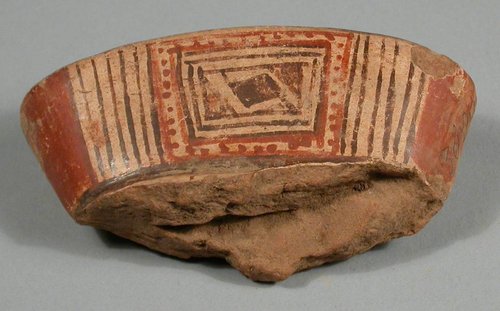Offener Kopfschmuck einer hohlen anthropomorphen Skulptur. Das Fragment wurde geglättet, geschlämmt, grundiert, bemalt und poliert. Grundierung und Bemalung sind partiell erodiert.
Das Objekt besitzt eine weiß-bräunliche Grundfarbe, die schwarz und rot bemalt ist. Der Kopfschmuck wurde mit vertikalen Linien und Bändern sowie mit einem Andreaskreuz verziert. Auf seiner Vorderseite befindet sich ein rechteckiges Bildfeld, das von einer gepunkteten roten Linie eingerahmt ist. Es zeigt zwei ineinander verschlungene Bänder, die eine rhombenförmige Schlaufe bilden. Ferrero (1975) und Healy (1980) erwähnen sitzende und stehende anthropomorphe Figuren, die einen offenen oder geschlossenen Kopfschmuck tragen können. Symbolische Bedeutung: Stevenson-Day (1997) interpretiert die weiblichen Skulpturen der Mora-Gruppe als Schamanen. Nach Lothrop 1926: highland polychrome ware.
Kulturelle Bedeutung: die Keramik der Mora-Gruppe wurde im Nordwesten von Costa Rica hergestellt und nach dem Zentralen Hochland und der Atlantikregion des Landes gehandelt. Sie verwendet gestalterische Elemente (sitzende anthropomorphe Figuren mit Kopfschmuck, Matten-Motiv, Kan-Kreuz), die auch aus der Maya-Keramik (Copador-Gruppe) des Clásico Tardío (900-600d.C.) bekannt sind. Die anthropomorphen Figuren der Mora Gruppe zeigen im Vergleich zu den anthropomorphen Skulpturen der zoniert zweifarbigen Keramik (Rosales Esgrafiado) und des Policromo Antiguo (Gruppe Galo Policromo) einen größeren darstellerischen Schematismus.
(Künne 2004)
Sammler: Lehmann, Walter
Angaben zum Fundort:
Costa Rica
Guanacaste (Provinz)
Lagartero (Ort)
en

